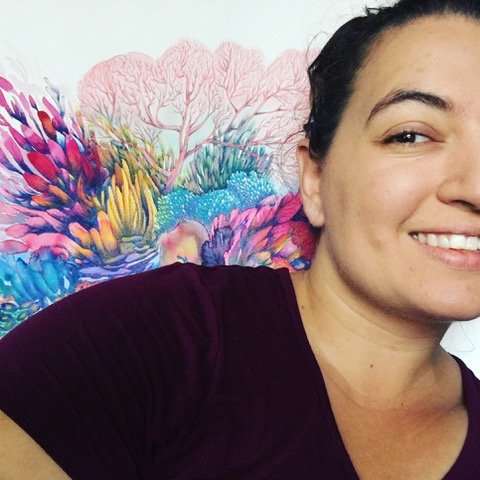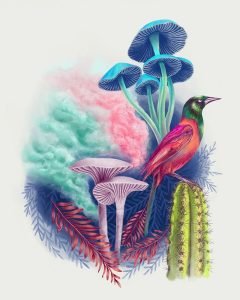An Interview with Allison LaValley
My Dear MilspoFANs-
I think it’s safe to say that if Allison LaValley sets her mind to something, she’s going to get it done- and have some fun along the way. Flexibility, creativity, and adventure have shaped her journey as an artist and military spouse. Like all of us who live the military family life, Allison finds unexpected ways to blossom. She is learning more about herself and exploring her artistry in ways that she might not have without a nudge from little things like moving across the globe, experiencing a tsunami, accepting difficult rules concerning military spouses working abroad, creating artwork without access to the spaces and materials she spent her MFA working with, and mothering small children!
As always, Allison’s beautiful artwork speaks for itself. But, I’m very pleased to share a little more about the woman behind the work. Enjoy!
You can find more of Allison’s work at: http://allisonlavalley.com and https://www.instagram.com/lostbirdsart/
MilspoFAN: Tell us a little about yourself, your journey as a military spouse, and where you are today.
Allison: I’m originally from Portland, Oregon, but I moved to Oahu in 2003 to attend the University of Hawai’i at Mānoa. I’ve loved art since I was a kid. So, despite my efforts to study more “practical” subjects, I couldn’t keep away from the art department and eventually earned my BFA. U.H.M. has an amazing glass studio, and that’s where I spent most of my time while in school.
I met my husband right after earning my degree. He’s a Chinese linguist in the Navy. When I met him, he already knew he was going overseas, and deciding to leave the islands and follow him to Japan was the beginning of a very eventful time in my life. I traveled back and forth between Oregon and Japan, took a six-month job in Antarctica to fund it, got stuck in Tokyo during the big earthquake and tsunami in 2011, and we finally got married a week after that.
We spent about six years in Japan, where both of our kids were born. Then, at the end of 2015, we came full circle back to Hawai’i where we are today. My husband just passed 13 years with the Navy, so it looks like he’ll stay until retirement.
MilspoFAN: How has your role as a military spouse impacted your work as an artist- creatively, logistically, or otherwise?
Allison: Things may have been different if our very first duty station hadn’t been overseas, but there are a lot of obstacles when you’re a guest in another country. I was also just out of school and hadn’t established myself as an artist yet, so it wasn’t an easy start. The materials I was used to working with were hard to find or to ship. There were a lot of rules about selling things or running a business as a foreign guest, and there weren’t local galleries or local artists I could connect with, especially with the language barrier. It’s easier now that we’re back in the states, but in a lot of ways, I feel like I’m starting over or starting late when it comes to pursuing a creative career.
On the other hand, the military has given us financial stability. There’s no pressure for my artwork to be a substantial source of income, so I have a lot of freedom to try a lot of different things…even if I had to start thinking in terms of portability, access to materials, and overall practicality when it came to small living spaces or PCSing. In Japan, I started making jewelry, I learned to knit and work with fiber, I taught classes, I had a small fiber business for a short time, and in general, I scratched my creative itch with a lot of crafty projects that didn’t take up a lot of space or resources. These are things I may not have tried, or skills I may not have learned if I had just been able to keep working the way I was already used to.
Now that we’ve been back in the states for a couple years, I’ve been able to connect with the local art community again, exhibit work, and think more seriously about the business side of art. I may have a lot of insecurities about how long I was “away,” but I’m also bringing a lot more life experience to the table now.
MilspoFAN: Describe for us your creative work and the aesthetic of your painting and how it has developed over time.
I haven’t always been a painter. In fact, I worked mostly three-dimensionally until a few years ago, after my second child was born. Then one day, when I was picking out some new art materials for the kids, I decided to buy a cheap set of watercolor tubes for myself as well. Watercolors had always intimidated me, but because I was using cheap materials I didn’t have to worry about wasting them. I played around without trying to follow any rules, and all of a sudden I discovered I really enjoyed them. I loved the ways the pigments would bleed and react to each other, I loved their transparency, and I loved the process.
Since then, I’ve continued to refine my technique, and I’ve upgraded my materials, but the process has stayed largely the same. I think of my paintings less as traditional watercolors (that slowly build up an image in layers), and more like Japanese Sumi-e or brush calligraphy. I like to lay down all of the brush strokes in one sitting, quickly and intuitively, before the paint dries. It preserves a certain energy and movement, and it prevents muddying pigments by overworking them. Color plays an obvious roll, and my goal is always to preserve that transparent, glowing luminosity of certain pigments. I don’t often work directly from reference, but I may look at photos for inspiration or be thinking of a flower I saw at the botanical garden. Finally, I like to go back in and add some dimension to the paintings with quick strokes of India ink and a dip pen.
After I started painting, the thing that really helped me most to improve and develop this style was deciding to take on a 100-day project. The idea was to make something every day for 100 consecutive days, posting each one online. I did 100 days and got so much out of it that I did 166 more, though not entirely consecutively. Daily practice makes such a huge difference. It’s the number one thing I’d recommend to anyone looking to improve or to find their style. They’re certainly not all masterpieces, but the project still lives on Instagram, and it serves as a neat visual record of how my paintings have changed over time: https://www.instagram.com/lostbirdsart/
MilspoFAN: You turned a car into a moving (literally!) work of art. Tell us the story of how that came to be.
Allison: This was a long time ago now, but the Sharpie car is still something I’m pretty proud of, if for no other reason than actually completing it. My husband had a scratch on the bumper of his car that he planned to have repainted, so we decided to have some fun and draw all over it first. He liked the way it looked, so he asked me to keep going. We didn’t have kids at the time, so it became the thing that kept me busy “making” while I was in Japan without a job. I easily spent 200 hours and a couple months free-drawing the tedious pattern, but it was pretty eye-catching when it was finished. It also got attention because it was a sports car that’s often admired by car enthusiasts, and so the project even enjoyed a brief viral moment on the internet a few years later (in a way that a Sharpie Toyota Corolla, for instance, might not have):
https://mymodernmet.com/r33-nissan-skyline-gtr-sharpie-art/
http://twistedsifter.com/2014/10/artist-uses-sharpie-to-give-skyline-one-of-a-kind-paint-job/
I actually applied a similar pattern just to the lower sections of another car we bought later on, but this time I scanned the drawings into the computer and made them into silver vinyl decals with a plotter.
MilspoFAN: How has motherhood impacted your artistic work?
Allison: I’m incredibly lucky that I’ve been able to stay home to raise my kids, but there’s no question that my art practice has been molded around my primary job as a parent. In terms of logistics, this means working most often at night after bedtime, or when my husband can take over on weekends. Even though I have another space, I like to work at the dining table in the middle of our main living space because I can more easily pick up and set down my brush whenever there’s a spare moment between other activities. I can’t devote as much uninterrupted time to art making as I might like to, but in a way that also makes me more focused and purposeful with the amount of time that I do have.
Being a parent has also helped me let go of a lot. When I started painting, I had to just do it, and I had to do it quickly. My kids were still small and very dependent on me for everything, so I didn’t have hours and days to devote to a single piece. I couldn’t even spare the brain power most days to think too long or too deeply about what I was making. So, I just painted what came to me intuitively. It was incredibly liberating to work on instinct and to make something that could just be beautiful or visceral, without changing the world. I painted just for myself at first, but I started getting feedback from others that made me realize there might be merit in the work outside of my own enjoyment of the process.
In the end, raising small kids is another season of life. As my youngest gets closer to kindergarten and I anticipate more time to myself, my work may shift again.
MilspoFAN: What’s next for you?
Allison: I’ve started to think more about the business side of art recently. While not currently necessary, it’s always been my dream to earn a living from art or creative work. So, I’m trying to practice good working habits now for that time when my kids are both in school and my husband is out of the military. I’d like to exhibit more, and I’m also looking for markets outside of the gallery where my work could have value, even on a more commercial level. I think it’s hard to make a living as an artist without diversifying your business in some way, but luckily there are a lot of possibilities these days. I’ve even started to explore working digitally, and the results have been very different from my current watercolors.















